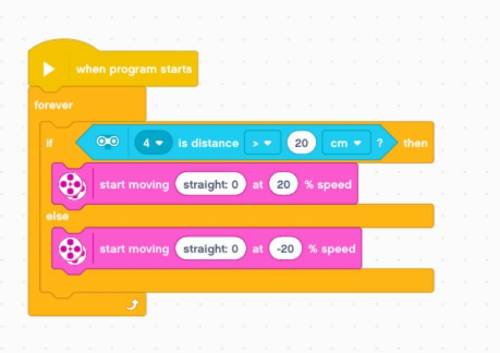
Computers and Technology, 11.12.2020 05:30 aashna66
Your robot will drive forward until it gets closer than 20 cm from a wall , then drive backwards until the robot is between 15 and 20 cm away from the wall, then stop the robot. The attached file can get you started with the robot moving back and forth forever.


Answers: 1
Another question on Computers and Technology

Computers and Technology, 23.06.2019 09:00
Design a class tictactoe that: holds the following information about the game: two-dimensional array (3 by 3), and winner. add additional variables as needed. includes the functions to perform the various operations on objects. for example, function to print the board, getting the move, checking if move is valid, determining if there is a winner after each move. add additional operations as needed. includes constructor(s). write the functions of the class, and write a program that uses the class. the program should declare an object of type tictactoe. the program will create the board and store it in the array. the program will allow two players to play the tic-tac-toe game. after every valid move update the array, check if there is a winner. if there is no winner and no tie, then print the board again to continue.
Answers: 2

Computers and Technology, 23.06.2019 19:30
You can apply several different worksheet themes from which tab?
Answers: 1

Computers and Technology, 24.06.2019 14:40
Create a function (prob3_6) that will do the following: input a positive scalar integer x. if x is odd, multiply it by 3 and add 1. if the given x is even, divide it by 2. repeat this rule on the new value until you get 1, if ever. your program will output how many operations it had to perform to get to 1 and the largest number along the way. for example, start with the number 3: because 3 is odd, we multiply by 3 and add 1 giving us 10. 10 is even so we divide it by 2, giving us 5. 5 is odd so we multiply by 3 and add one, giving us 16. we divide 16 (even) by two giving 8. we divide 8 (even) by two giving 4. we divide 4 (even) by two giving 2. we divide 2 (even) by 2 to give us 1. once we have one, we stop. this example took seven operations to get to one. the largest number we had along the way was 16. every value of n that anyone has ever checked eventually leads to 1, but it is an open mathematical problem (known as the collatz conjectureopens in new tab) whether every value of n eventually leads to 1. your program should include a while loop and an if-statement.
Answers: 3

Computers and Technology, 25.06.2019 05:30
Your mother is sure that you were driving too fast because she knows a. when you arrived and the direction you came from. b. how long it took you to get home and how far you traveled. c. what time you left and how long it took you to get home. d. the direction you were driving and how far you traveled.
Answers: 2
You know the right answer?
Your robot will drive forward until it gets closer than 20 cm from a wall , then drive backwards unt...
Questions






Health, 28.09.2019 00:00

Mathematics, 28.09.2019 00:00

Mathematics, 28.09.2019 00:00

Arts, 28.09.2019 00:00


History, 28.09.2019 00:00


English, 28.09.2019 00:00

Biology, 28.09.2019 00:00

History, 28.09.2019 00:00

Mathematics, 28.09.2019 00:00



Mathematics, 28.09.2019 00:00

Computers and Technology, 28.09.2019 00:00



